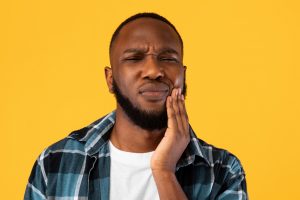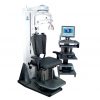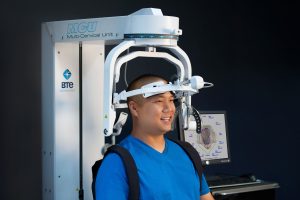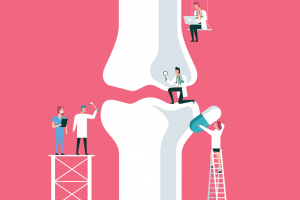
TMJ Disorders and Interventions
Treatment GuidelinesContrary to popular belief, TMJ is not technically a diagnosis. TMJ stands for the Temporomandibular Joint itself. Conditions of this joint can cause pain and clicking in the jaw.
Contrary to popular belief, TMJ is not technically a diagnosis. TMJ stands for the Temporomandibular Joint, found on the side of the face, near the ear. This joint is the connection between the jaw and skull.
The term TMJ usually refers to several disorders that affect this joint and the surrounding area. Conditions of this joint, like TMD (temporomandibular disorder), can cause pain and clicking in the jaw.Since this is ultimately a musculoskeletal issue, chiropractic care and physical therapy can help treat and prevent it. Within these disciplines, several treatment techniques can provide relief, such as manual therapy, relaxation, physical agent modalities, stretching, and exercise. Let’s explore these interventions and how they can benefit your patients.
Overview of TMJ
The Temporomandibular Joint opens the jaw and allows for more refined jaw movements. The joint operates as a hinge, opening and closing the jaw. But the joint can also glide, as the jaw has a variety of movement functions.
TMJ disorders can result from skeletal components or issues with the surrounding musculature. These disorders are most common in adults between the ages of 20 and 40. Signs and symptoms of Temporomandibular Disorders include:
- Jaw pain
- Popping or clicking when opening and closing the jaw
- Pain in the head or face
- Locking of the jaw, making it difficult to open or close
- Pain and tenderness when chewing
Trauma to the joint itself is the leading cause of dysfunction. Physical trauma to the jaw, such as in an accident, is a common source. Degenerative trauma may also lead to problems, such as arthritis or connective tissue diseases. Trauma may be self-inflicted, in a manner of speaking, from grinding or clenching of the teeth. Approximately one in 12 adults in the United States suffers from TMJ, but only about half of them pursue treatment to address it.
How To Treat TMJ
Treatment methods for TMJ vary from simple rest to surgical intervention. Most cases fall between the two. Surgery is rare but typically comprises a minor procedure performed in a doctor’s office.
Manual therapy techniques can address tightness or limited mobility. Teaching relaxation techniques can improve stress management and decrease clenching or grinding of teeth. Physical agent modalities such as ice, TENS units, and ultrasound can relieve pain. Active exercise and stretches can address muscle weakness, and manual adjustments can correct skeletal dysfunction.
In addition, postural dysfunction aggravates TMJ issues. In fact, up to 70% of TMJ patients have coexisting problems with their neck and back. Addressing postural concerns can also help relieve TMJ symptoms.
TMJ Treatment: Manual Techniques
Manual therapy techniques can provide additional relief for TMJ disorders. Manual adjustments to the neck and back can improve postural alignment and relieve the pressure on the joints. Practitioners can also perform jaw adjustments to correct the joint’s misalignment.
Performing ischemic compression on the surface of the jaw can provide increased blood flow and decrease pain. Active release techniques and reciprocal inhibition stretches can increase the range of motion, and decrease pain caused by tightness.
TMJ Treatment: Physical Agent Modalities
If you need to address immediate symptoms, physical agent modalities can help. Heat and ice can address initial swelling and pain. Application of moist heat for up to 15 minutes helps relax the area. Similarly, a TENS unit can reduce pain, especially before beginning treatment. Ultrasound can also lengthen the surrounding musculature and decrease tightness and discomfort.
TMJ Treatment: Stretching and Mobilization
Massage and mobilization of the jaw and surrounding area can relieve pain, especially for the temporalis muscle or the masseter. Massage and trigger point release of the neck and upper back can also be helpful.
Specific stretches to relieve jaw pain make a powerful difference. For a particular jaw stretch, have the patient sit upright. Instruct them to close their mouth with their teeth touching but not clenched. Next, have the patient bring their tongue to the roof of the mouth. As the patient does so, instruct them to bring the tongue back as far as possible with the teeth closed. While keeping the tongue in place, the patient will open their mouth. They will do so slowly, stopping once the tongue begins to pull away. They will hold this position for five seconds, then slowly close the mouth.
Repeat this exercise 10 times at first, twice a day, and increase according to the patient’s tolerance. Though the patient may initially feel discomfort, this stretch will improve the jaw’s mobility and range of motion.
TMJ Treatment: Exercise
While stretches lengthen tight muscles, exercises will strengthen the jaw to prevent further injury. Working the muscles surrounding the temporomandibular joint will relieve pain and discomfort. Good results also come from working to stabilize the neck.
Rather than only focusing on the jaw, a patient can decrease any extra stress placed on the joint by working on postural muscles. For example, planks are the ultimate core technique. By strengthening abdominals and spinal erectors, patients can rectify postural issues contributing to their jaw pain.
In addition to planks, specifically targeted exercises can help to build up jaw strength. For example, chin tucks, or cervical retraction exercises, address the neck and jaw directly. With the patient standing or sitting upright, instruct them to place a hand on their chin. With their shoulders back and down, they should bring their chin back to form a “double chin.” After maintaining it for a few seconds, they can then relax. The patient can repeat this 10 times.
Resisted movement isometric techniques can also serve to exercise the temporomandibular musculature. Have the patient place a few fingers on one side of the chin. For about five seconds, have them apply pressure with their hand but maintain good jaw alignment. It may be helpful to perform this exercise in a mirror for correct alignment and good feedback. After those five seconds, the patient can rest and repeat two to three more times. Your patient can repeat this exercise on the other side.
TMJ Treatment: Functional Exercise With MCU
While these simple exercises can provide adequate relief, the best way to provide long-term recovery is with evidence-based, functional exercise. The MCU or Multi-Cervical Unit by BTE, works by objectively evaluating the neck’s strength and ROM, providing a roadmap for treatment. From there, personalized exercises strengthen the cervical spine to improve symmetry, decrease pain, and prevent injury.
“For neck rehab, the MCU does what TheraBands and manual therapy can’t do. Those other techniques can’t provide a graded resistance with consistent weight all the way through the range of motion. And the MCU provides objective feedback with graphs and data all shown in the progress reports.” – Natalie Perkins, Physiotherapist and Owner of Sydney Whiplash Centre
Chiropractors and Physical Therapists both treat TMJ with outstanding clinical outcomes on the MCU. Dr. Edo Zylstra states, “I wouldn’t practice without it… It’s the most important reason why patients get better for the long term versus just managing symptoms.” Read more about Dr. Zylstra’s evidence-based approach to neck treatment here.
In terms of patient results, the MCU has proven effective at reducing the Numerical Rating Scale of Pain. According to a recent study, treatment with MCU reduced this pain rating by 35.5% in chronic neck pain patients.
One Chiropractor even experienced the MCU as a patient, before making it a cornerstone of his practice. Dr. Marc Weinberg says, “The MCU is a game changer for you, your clients, and your practice.” Read Dr. Weinberg’s harrowing personal injury story that led to his ultimate clinical and business success with MCU here.
TMJ Treatment: Other Recommendations
A variety of alternative techniques can supplement Physical Therapy and Chiropractic treatment. Cupping, often using plastic or silicone cups, could relieve pressure and increase blood flow to the area. Instrument-Assisted Soft Tissue Mobilization (IASTM), including gua sha and Graston techniques, may break up any tightness in the surrounding musculature.
Relaxation techniques like deep breathing can relieve stress. Other stress management techniques can decrease teeth grinding and clenching, which may be causing or exacerbating the symptoms. Ergonomic recommendations can also provide benefits. By reducing the strain placed on postural muscles and the neck, practitioners can increase carryover of the benefits from therapy.
Conclusion
Temporomandibular Joint Dysfunction can cause pain, discomfort, and decreased functional abilities. By providing physical agent modalities, stretches, exercise, and manual therapy techniques, you can provide relief. About 35 million people in the country suffer from TMJ dysfunction. Help them in your practice today!
References
- Torchio, A. 2016. “Stop the Pop”. Pangea Chiropractic https://pangeachiropractic.com/chiropractic-adjustments-for-tmj/#:~:text=Chiropractic%20adjustments%20for%20TMJ%20focus,is%20common%20in%20treating%20TMJ.
- Kalkstein, B. 2022. “Best Chiropractic TMJ Adjustment”. Kalkstein Chiropractic. https://www.towsonchiro.com/best-chiropractic-tmj-adjustment-how-a-chiropractor-can-help/
- “Temporomandibular Joint Exercises”. 2019. NHS: King’s College Hospital. https://www.kch.nhs.uk/Doc/pl%20-%20868.1%20-%20temporomandibular%20joint%20(tmj)%20exercises.pdf
- Friedman, K. 2020. “4 Shocking Statistics About TMJ Disorders”. Oral Facial Surgery. https://oralfacial.com/tmj-in-coral-springs-stats/
- “Temporomandibular Joint (TMJ) Disorders”. 2021. Cleveland Clinic. https://my.clevelandclinic.org/health/diseases/15066-temporomandibular-disorders-tmd-overview
- “TMJ Disorders”. 2018. Mayo Clinic. https://www.mayoclinic.org/diseases-conditions/tmj/diagnosis-treatment/drc-20350945
- Devarapalli, V. 2020. “Can Seeing a Physical Therapist Cure my TMJ?”. Pace PT.https://paceptclinic.com/patient-information/can-seeing-a-physical-therapist-cure-my-tmj/
- Choi, N. 2022. “What Temporomandibular Joint (TMJ) Exercises Relieve Pain?”. Healthline. https://www.healthline.com/health/tmj-disorders#outlook
- Physiotherapy management of Temporomandibular Joint (TMJ) pain”. 2012. NHS: Royal Surrey County Hospital.
- Karegeannes, M. 2014. “TMJ Treatment”. Freedom PT. https://www.treatingtmj.com/wp-content/uploads/Exercises-for-TMJ-Self-Massage.pdf
- Lawson, E. 2015. “TMJ Exercises”. Oxford University Hospitals. https://www.treatingtmj.com/wp-content/uploads/Exercises-for-TMJ-Self-Massage.pdf
- Weber, K. 2007. “Standard of Care: Temporomandibular Joint Disorder”. Brigham and Women’s Hospital. https://www.brighamandwomens.org/assets/BWH/patients-and-families/rehabilitation-services/pdfs/tmj-disorder.pdf
- Cox, L. 2020. “Progressive resistance exercise for improving pain and disability in chronic neck pain: A case series.” Physiotherapy Research International. https://doi.org/10.1002/pri.1863





